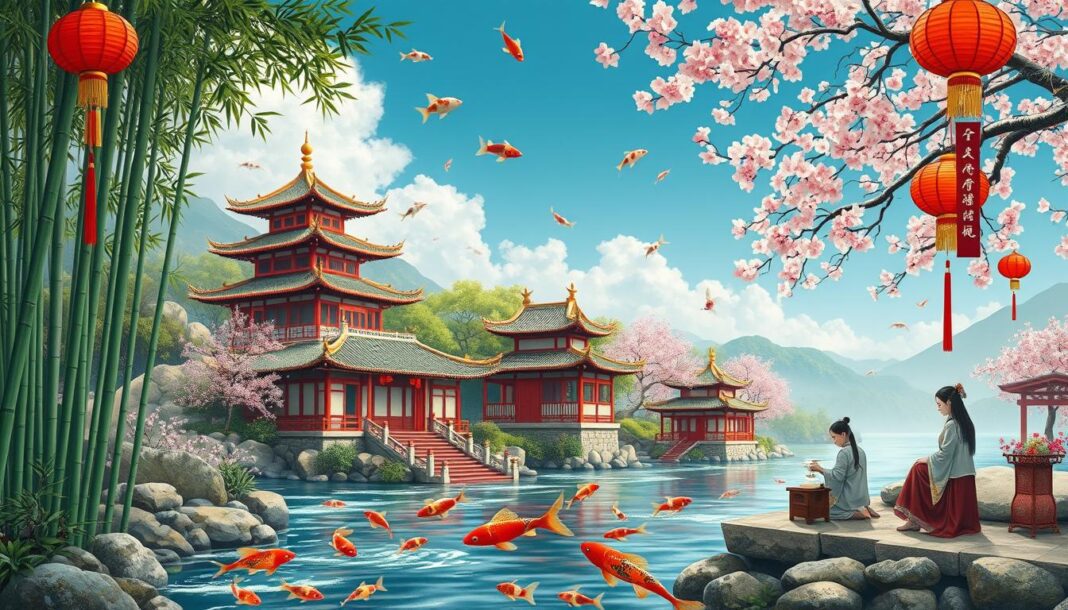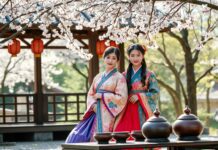Start an exciting journey into the world of Chinese culture. It’s filled with ancient traditions and a lasting impact on history. From Confucianism’s wisdom to the art that has amazed people for ages, Chinese culture is a mix of old and new.
Learn about the Chinese language, the tasty dishes of its cuisine, and the joyful festivals that unite people. Let’s dive into the rich and varied world of Chinese culture. You’ll gain new insights that will make you appreciate this amazing civilization even more.
Key Takeaways
- Explore the ancient roots and enduring traditions of Chinese culture.
- Discover the philosophical foundations that have shaped Chinese civilization.
- Immerse yourself in the vibrant world of Chinese arts and literature.
- Embark on a culinary journey through the diverse flavors of Chinese cuisine.
- Celebrate the rich tapestry of Chinese festivals and customs.
- Uncover the intricacies of the Chinese language and its intricate dialects.
- Gain insight into the influential role of Taoism and other philosophical traditions.
Chinese Culture: A Captivating Tapestry of History and Heritage
China’s culture has amazed people worldwide for centuries. Its history goes back thousands of years, starting with the dawn of civilization. Chinese culture is a mix of ancient wisdom and modern energy.
Exploring China’s Ancient Roots
The early dynasties and civilizations in China laid the foundation for its culture. The Xia, Shang, and Zhou dynasties were key in developing Chinese philosophy, art, and literature. They set the stage for China’s lasting culture, history, and heritage.
- The Xia Dynasty (c. 2070-1600 BCE) is the first recorded Chinese dynasty. It started the centralized state and bureaucracy.
- The Shang Dynasty (c. 1600-1046 BCE) brought Chinese writing and bronze casting. It also grew religious and political institutions.
- The Zhou Dynasty (c. 1046-256 BCE) was a time of great philosophy. Confucius and Laozi’s teachings shaped China for centuries.
The Enduring Legacy of Confucianism
Confucianism is at the heart of Chinese culture, history, and heritage. It was developed by Confucius (551-479 BCE). Confucianism has deeply influenced China’s society, politics, and family structures.
“The nucleus of Confucian thought is the idea that the individual can attain spiritual and moral perfection through the cultivation of virtue and the fulfillment of social roles and responsibilities.” – Fung Yu-lan, renowned Chinese philosopher
Confucianism’s values, like filial piety and respect for elders, are deeply rooted in Chinese culture. These values have shaped China’s society and politics for over two millennia.
The Vibrant World of Chinese Arts and Literature
China’s rich culture shines through in its art and literature. The art of Chinese calligraphy and the beauty of Chinese poetry have won hearts globally. These artistic wonders show the skill, creativity, and cultural value that make them special.
From Calligraphy to Poetry: Artistic Expressions Unveiled
Chinese calligraphy is a highly respected art form. It’s not just beautiful writing; it’s a deep expression of the artist’s feelings and connection to nature. Each brush stroke is a perfect blend of control, balance, and rhythm.
The Chinese arts of poetry and literature are also mesmerizing. Chinese poets are known for capturing human experiences in their verses. Their works, from ancient to modern, offer a glimpse into China’s culture and the human condition.
Exploring Chinese calligraphy or poetry is a journey into the soul of an ancient civilization. It inspires and moves people everywhere, showing the timeless beauty of Chinese arts.
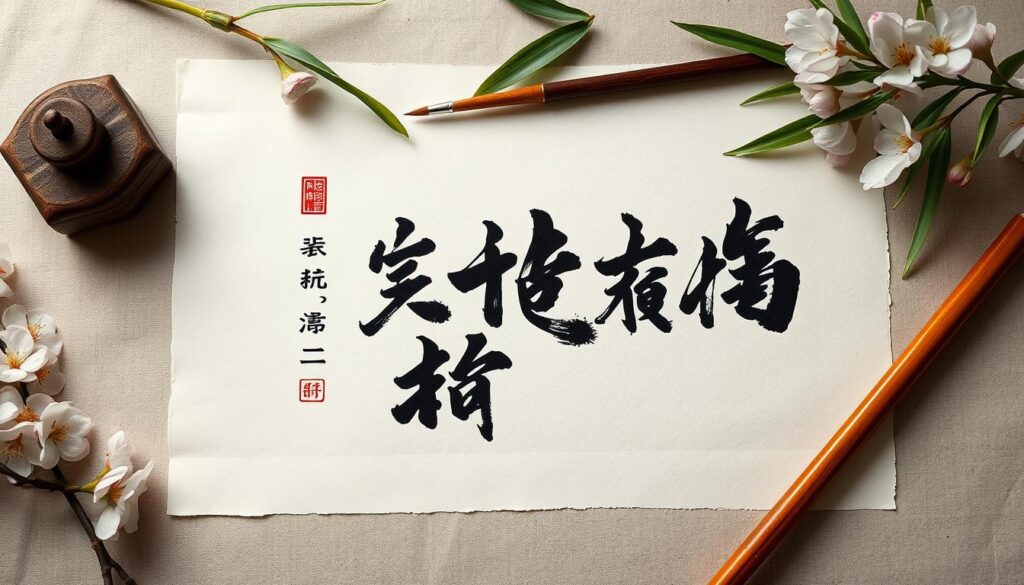
Culinary Delights: A Journey Through Chinese Cuisine
Chinese cuisine is a world of flavors and techniques that excites food lovers everywhere. It ranges from spicy Sichuan dishes to delicate Cantonese treats. This journey lets you see the amazing diversity of Chinese food.
Regional Specialties and Flavors Galore
China’s vast lands have created many regional cuisines. Each has its own special ingredients, cooking ways, and tastes. Let’s explore some of China’s most loved regional dishes:
- Sichuan Cuisine: Known for its bold, spicy flavors and Sichuan peppercorns. It’s famous for dishes like Kung Pao Chicken and Mapo Tofu.
- Cantonese Cuisine: From Guangdong province, it focuses on fresh ingredients and delicate cooking. It’s known for Dim Sum and Roast Goose.
- Hunan Cuisine: From Hunan province, it’s known for its strong, pungent flavors and chili peppers. Try Chairman Mao’s Braised Pork.
- Northern Chinese Cuisine: It features hearty dumplings and Peking Roast Duck. It shows the region’s cold climate and farming history.
Trying these dishes is like going on a culinary adventure. Each bite shows the amazing variety of Chinese food.
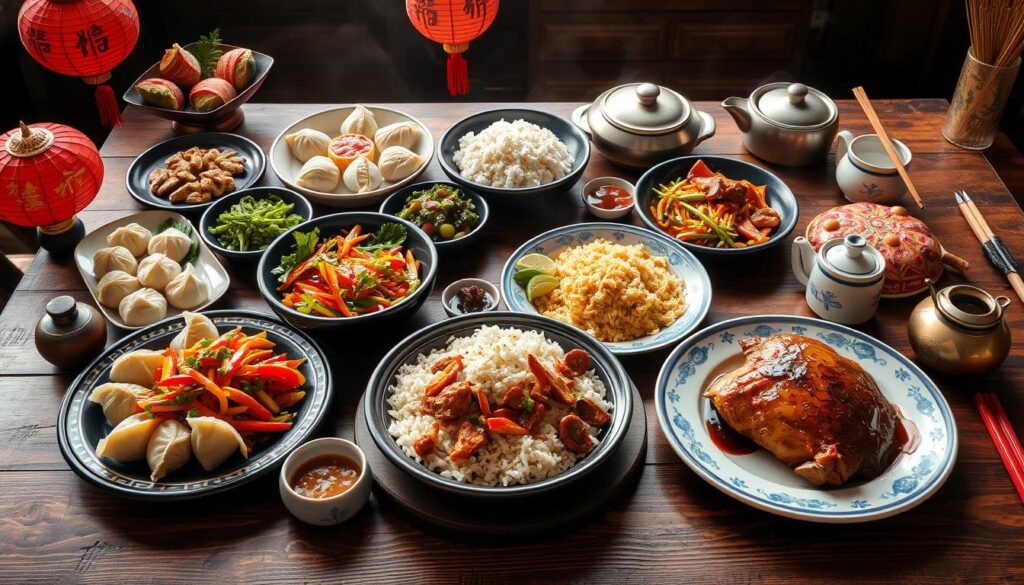
| Regional Cuisine | Signature Dishes | Key Ingredients and Flavors |
|---|---|---|
| Sichuan Cuisine | Kung Pao Chicken, Mapo Tofu | Sichuan peppercorns, chili peppers, bold, spicy flavors |
| Cantonese Cuisine | Dim Sum, Roast Goose | Fresh, high-quality ingredients, delicate preparation |
| Hunan Cuisine | Chairman Mao’s Braised Pork | Chili peppers, pungent flavors |
| Northern Chinese Cuisine | Dumplings, Peking Roast Duck | Wheat-based, hearty, savory |
“Chinese cuisine is not just a meal, but a journey through a rich cultural tapestry, where every bite tells a story of centuries-old traditions and regional diversity.”
Celebrating Chinese Festivals and Traditions
China’s culture is rich and colorful, filled with festivals and traditions. These celebrations show the spirit of the Chinese people. From the Lunar New Year to the Mid-Autumn Festival, they bring joy and connect us to the past.
The Lunar New Year, or Spring Festival, is a big deal in China. It’s a two-week celebration that starts a new year. People enjoy parades, family time, feasts, and giving red envelopes with money.
The Lantern Festival ends this celebration. It’s when people release lanterns into the sky. This symbolizes wishes for a good year.
The Mid-Autumn Festival is another important tradition. It’s a harvest celebration in the eighth lunar month. Families come together to see the full moon, eat mooncakes, and enjoy dragon dances and lanterns.
| Chinese Festival | Significance | Customs |
|---|---|---|
| Lunar New Year | Marks the beginning of a new lunar calendar year | Parades, family reunions, feasting, red envelope exchange |
| Mid-Autumn Festival | Celebrates the harvest and the full moon | Admiring the moon, sharing mooncakes, dragon dance, lantern lighting |
These festivals and traditions show the beauty of Chinese culture. By celebrating them, we learn more about Chinese heritage.
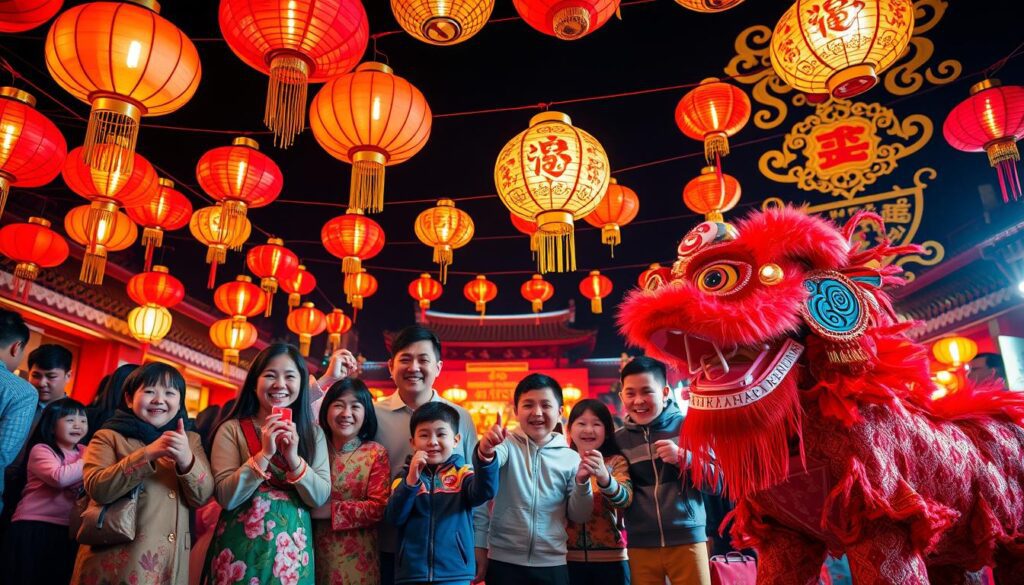
“Chinese festivals and traditions are more than just celebrations – they are a testament to the enduring spirit and rich heritage of the Chinese people.”
The Chinese Language: A Window into a Vast Culture
The Chinese language is a window into China’s rich culture. Mandarin Chinese is the most spoken dialect. But, there are many other dialects that show the local traditions and identities.
Exploring the Intricacies of Mandarin and Its Dialects
Mandarin Chinese is known for its tones and complex characters. It shows the creativity of the Chinese language. From northern to southern dialects, each has its own cultural flavor.
- Mandarin Chinese: The most widely spoken Chinese language dialect, with its roots in northern China.
- Cantonese: A vibrant dialect originating in southern China, known for its musical tonality and extensive use in film and television.
- Min: A family of dialects found in the coastal regions, including the renowned Fuzhou and Xiamen dialects.
- Wu: Spoken in the eastern provinces, this dialect is characterized by its nuanced tones and literary influences.
These dialects show the rich language of China. They also reflect the deep connection between language and culture. Each dialect tells the story of its region, giving us a peek into Chinese culture.
“The Chinese language is not merely a tool for communication; it is a living embodiment of the country’s cultural heritage, weaving together the stories and traditions of its people.”
As the world gets more global, learning about the Chinese language and its dialects is more important. Understanding these can help us appreciate China’s vast and fascinating culture.
Chinese Culture and Philosophy: Taoism and Beyond
Chinese culture is deeply rooted in a rich tapestry of philosophical traditions, with Taoism being one of the most influential. Taoism, or “the Way,” emphasizes the importance of living in harmony with the natural flow of the universe. It encourages simplicity and cultivating inner peace.
At the heart of Taoism lies the concept of the “Tao,” a fundamental principle that is both the source and the ultimate reality of all existence. Taoists believe that by aligning themselves with the Tao, individuals can achieve a state of balance, serenity, and contentment.
- The Yin and Yang: Taoism’s iconic symbol of complementary opposites, representing the dynamic balance of the universe.
- Wu Wei: The art of effortless action, allowing things to unfold naturally without forceful intervention.
- Zhuangzi and Laozi: Two of Taoism’s most influential philosophers, whose writings have shaped the philosophical foundations of the tradition.
Beyond Taoism, Chinese culture has also been profoundly influenced by other philosophical schools of thought, such as Confucianism and Buddhism. Confucianism emphasizes the importance of social harmony, moral cultivation, and ethical behavior. Buddhism has introduced concepts like enlightenment, reincarnation, and the interconnectedness of all beings.
“The Tao that can be told is not the eternal Tao. The name that can be named is not the eternal name.”
– Lao Tzu, Tao Te Ching
The interplay of these diverse philosophies has given rise to a rich and nuanced understanding of the human experience. It guides the Chinese people in their approach to life, relationships, and the pursuit of personal and societal fulfillment.
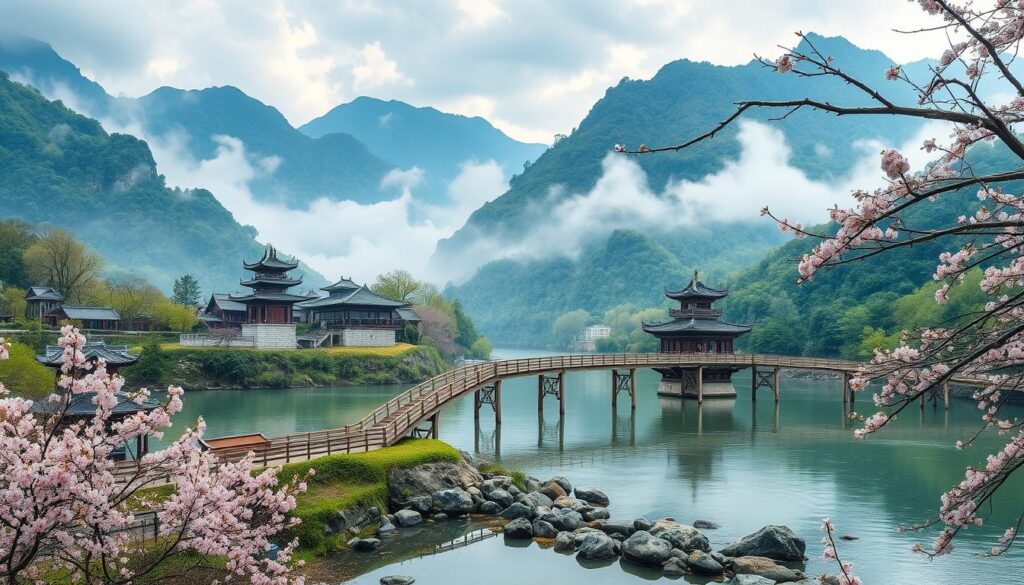
By exploring the depth and complexity of Chinese philosophy, we can gain valuable insights into the cultural traditions that have shaped the Chinese worldview. These traditions continue to influence the global community.
The Chinese Diaspora: Spreading Traditions Worldwide
The Chinese diaspora has spread Chinese culture all over the world. This has led to a rich mix of cultural diversity and cultural fusion. Chinese traditions have made the world a more colorful place.
Embracing Cultural Diversity and Fusion
Chinese communities around the globe have mixed their customs with local ones. This has created unique cultural blends. Traditional Chinese elements now mix with local ones.
The Peranakan culture in Southeast Asia is a great example. It combines Chinese and Malay traditions. Peranakan food, buildings, and language show how these cultures have merged over time.
Chinatowns in big cities are also full of cultural diversity. They mix Chinese art, food, and traditions with local ones. These areas show how the Chinese diaspora keeps its heritage while adapting to new places.
| Region | Cultural Fusion Example |
|---|---|
| Southeast Asia | Peranakan culture (Nyonya or Baba Nyonya) |
| Worldwide | Chinatowns in major cities |
The Chinese diaspora has made the cultures of their host countries richer. It has also helped people understand and appreciate Chinese culture worldwide.
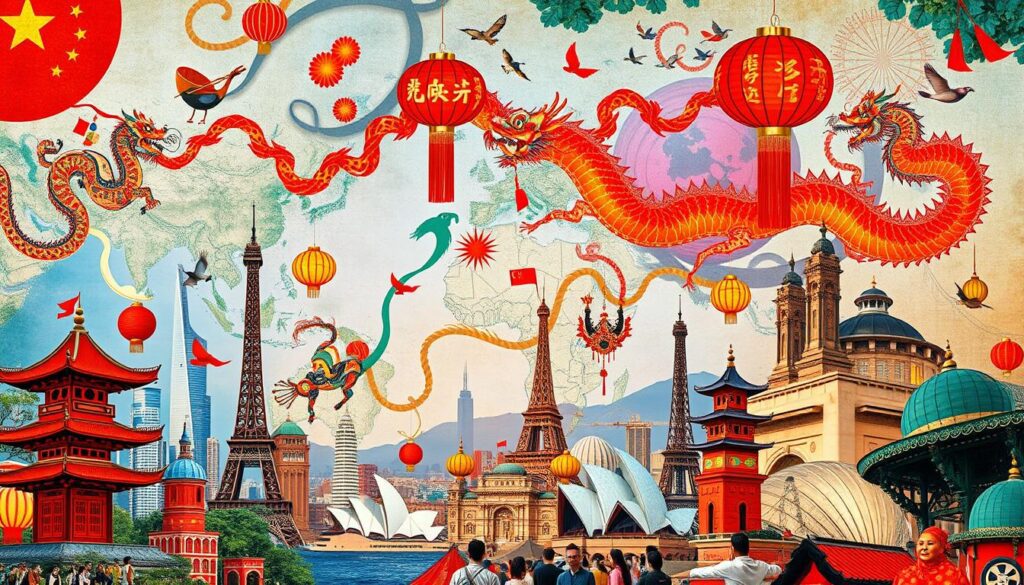
Chinese Culture Through the Ages: Dynasties and Empires
China’s culture has been shaped by many dynasties and empires over time. The Xia Dynasty was the first recorded ruling house in China. The mighty Ming Dynasty and the last Qing Dynasty also left their mark. Each era has influenced the traditions and customs of Chinese civilization.
Figures like Emperor Qin Shi Huang and Confucius have shaped Chinese culture. Qin Shi Huang unified China and built the Great Wall. Confucius’ teachings still guide modern Chinese society. The Tang and Song Dynasties are known for their artistic and architectural achievements.
Chinese culture has shown great resilience and adaptability through dynastic changes. The Forbidden City and classical Chinese paintings showcase China’s grandeur and beauty. These legacies continue to inspire people worldwide.
FAQ
What are the key aspects of Chinese culture that make it so fascinating?
Chinese culture is rich and diverse. It includes history, traditions, philosophy, arts, literature, cuisine, and language. These elements have drawn people from all over the world. From ancient times to today, Chinese culture offers a deep and rewarding experience.
What is the significance of Confucianism in shaping Chinese society and values?
Confucianism has deeply influenced Chinese society. It has shaped values, social structures, and ethics for thousands of years. Confucius’ teachings focus on family, harmony, and moral growth. These ideas are deeply rooted in Chinese culture.
How does Chinese art and literature reflect the country’s rich cultural heritage?
Chinese art and literature showcase the country’s cultural depth. They include calligraphy and poetry, showing skill and creativity. These works give insight into Chinese philosophy, emotions, and aesthetics.
What are some of the defining characteristics of Chinese cuisine?
Chinese cuisine is known for its varied flavors and cooking techniques. Each region in China has its own unique dishes. This reflects the country’s cultural diversity and culinary creativity.
What are some of the most important Chinese festivals and traditions?
Chinese culture celebrates many festivals and traditions. The Lunar New Year and Mid-Autumn Festival are key. These events show the joy and cultural significance of Chinese traditions.
How does the Chinese language reflect the country’s cultural diversity and identity?
The Chinese language is complex and diverse. It includes Mandarin and many dialects. This linguistic variety shows the deep connection between language and culture in China.
What are the core principles and teachings of Taoism, and how do they influence Chinese culture?
Taoism is a key philosophy in China. It emphasizes harmony with nature and balance. These teachings have shaped Chinese culture, influencing art, literature, and daily life.
How has the Chinese diaspora contributed to the global dissemination of Chinese culture?
The Chinese diaspora has spread Chinese traditions worldwide. People of Chinese descent have blended Chinese customs with local ones. This has enriched global culture and promoted understanding of Chinese traditions.
How have the various dynasties and empires throughout Chinese history shaped the evolution of its culture?
Chinese culture has grown through many dynasties and empires. Each has left a lasting impact. This history has shaped Chinese civilization and its global significance.
To read the latest articles please visit the home page of Turk Blogs.


